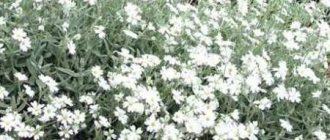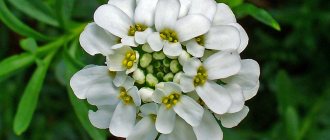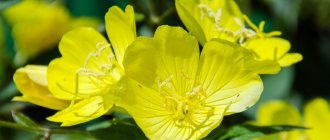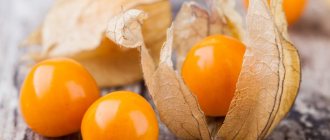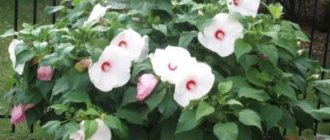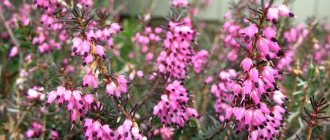General information
Asparagus, also known as asparagus, is a herbaceous plant species that reaches a height of about one and a half meters. Growing in one place for many years (up to 25), one plant can form about 50 valuable shoots.
Asparagus grows as a kind of bush, consisting of a tall, highly branched stem, divided into several smaller stems. Massive and juicy shoots (which are used as food) originate from many buds located on a powerful rhizome.
Asparagus feels comfortable in almost any climate and weather conditions: the plant can be found all over the globe, from sultry and hot Africa to cold and inhospitable Siberia.
An interesting fact is that despite the plant’s resistance to severe frosts, early light spring frosts can cause significant damage to asparagus.
In everyday life, asparagus is classified as a vegetable, among which it occupies an increasingly confident position every year. This is due not only to the unique taste of the plant, but also to its outstanding composition. Asparagus contains a lot of useful substances, vitamins and minerals, among which the most notable are:
- ascorbic acid;
- beta-carotene;
- iron;
- potassium;
- calcium;
- magnesium;
- manganese;
- copper;
- sodium;
- niacin;
- selenium;
- thiamine;
- folic acid;
- phosphorus;
- choline
What does asparagus look like?
Asparagus is essentially a fairly tall herb, although it most closely resembles a bush.
Its height can reach 1.5 m, and it consists of many thin and highly branched stems. The lower part of the shoots is bare, but on top the bush forms a lush crown that is pleasant to the touch. And all thanks to the small needle-like leaves, which are not prickly at all. But the main value of asparagus is hidden underground. The above-ground part of the bush (the one with a lush head of leaves) has no nutritional value. Florists will be more interested in her. But the root system is a real storehouse of vitamins. It consists of two components:
- thick horizontal root that feeds the plant;
- vertically growing shoots.
It is the latter that are a godsend for a gourmet. Their upper part, which tends to emerge from the soil, is that very asparagus.
Asparagus is a very profitable crop for gardeners because it is long-lived. Having planted it in the country, you can feast on young asparagus for two decades. It also grows quickly - daily growth ranges from 5 to 10 cm.
Landing
Before you start planting, it is important to get the area where the asparagus will grow in order. The plant requires drained neutral soil and a sunny location protected from strong winds. In addition, asparagus is in dire need of nitrogen, so to achieve success in growing the vegetable, it is necessary to dig up the future site in the fall, removing the roots of perennial weeds and adding quite a lot of rotted manure or garden compost. Acidic soils require liming.
Spring
In early spring, asparagus is planted until its buds begin to grow. During spring planting, the soil is generously fertilized with humus (at least 8 kilograms per 1 square meter).
When planting, you should maintain a distance between rows of at least 60 centimeters and 30 between plants in a row, since over time the bushes grow and require space for healthy growth. Thus, it turns out that per 1 square meter of land there are no more than 4 asparagus rhizomes.
The rhizome must be delicately placed in a pre-made trench 30 centimeters deep. When digging, leave a small depression, which will greatly simplify the watering procedure in the future. As soon as all the plants are planted, they must be fertilized with plenty of water.
You can clearly see how to plant asparagus in the spring in this video:
Autumn
Autumn planting also requires preliminary fertilization of the soil, but in this case humus will not work, and for each square meter of soil you will need:
- superphosphate – 60 grams;
- potassium sulfate – 30 grams;
- ammonium sulfate – 20 grams.
The distance between the rhizomes and the rows is maintained, however, unlike spring planting, it is necessary to make low mounds rather than depressions in the places where asparagus will grow. Such an organization will provide natural protection for asparagus roots from winter frosts.
If you need to obtain asparagus seeds, it is recommended to plant at least 2 plants.
Growing from seeds
Growing from seeds is the most common method. The method has its advantages and disadvantages. The latter includes a relatively poor seed growth rate. However, the asparagus that survives will grow strong and tall.
You should start growing in April, but before this moment the seeds must be pre-prepared: kept for several hours in a solution of potassium permanganate at room temperature.
Subsequent cultivation from seeds consists of several stages:
- To germinate seeds, you can use sawdust moistened for nutritional value or special peat tablets. Gauze or other damp cloth is not suitable for this purpose: weak asparagus roots will become entangled in the material and be injured. As germination progresses, it is necessary to maintain normal daylight hours, a temperature of 25 degrees Celsius and moderate humidity levels.
- As soon as the first shoots appear, the seeds are transplanted into peat cups with a volume of 100-200 milliliters with a garden mixture prepared in advance (soil from the future site for growing asparagus, mixed with sand and peat in a ratio of 2:1) to a depth of 2 centimeters. After 10 days, the seedlings should hatch.
- The resulting asparagus seedlings should be transferred to open ground in June or July. Next year, the emerging rhizomes can be transplanted to any convenient place without the risk of causing damage to the plant, and until then any movement is excluded.
Reproduction
Asparagus is not only quite easy to grow, but also to multiply the number of existing specimens. The easiest way to propagate asparagus is by dividing the bush during transplantation.
It is recommended to replant young asparagus every year, in any season, with the exception of winter. Mature plants are replanted every 10 years.
Cuttings
From last year's shoot of an adult plant, from March to June, it is necessary to cut cuttings. Plant the resulting future asparagus in pre-moistened sand, cover the top with any improvised translucent or transparent cap (for example, a large glass, half a plastic bottle, etc.).
Immersed cuttings should be regularly ventilated, removing the cap for several hours a day, and sprayed. After a month or a month and a half, the first roots should appear; as soon as they appear, the plant must be placed in a pot of a suitable size.
The resulting seedlings are suitable for planting next autumn.
Forcing in winter
Asparagus is a universal vegetable crop that can be successfully cultivated in any season, including winter. In the spring, greenhouses are used for this purpose, and in the winter, greenhouses are used.
You can get new representatives of asparagus in winter and early spring by forcing shoots. For this task, the rhizome of adult plants (at least 4 years old) is used. To achieve the goal, you must:
- Dig up the rhizomes in October and, before December, put them in a cool place (for example, in a basement or cellar), in which the temperature should be constantly maintained in the range of 0-2 degrees Celsius.
- When December arrives, in the early days, move the asparagus rhizomes into small containers, which must be placed in the greenhouse, compactly pressing against each other. At least 15 containers must fit on 1 square meter of area.
- Sprinkle a thick layer of humus on top (at least 15 centimeters), and additionally cover the containers themselves and wrap them in black film.
- Next, you will need to maintain a strict temperature regime. During the first week, the temperature in the greenhouse should be maintained at 10 degrees Celsius. As soon as the rhizomes begin to grow, increase the temperature to 18 degrees. This temperature must be maintained in the room for 2 months while the harvest takes place.
Care
In the second year after planting asparagus, mineral fertilizers are applied. The soil along the rows needs early and high-quality loosening. However, it is important to be careful not to damage the vulnerable roots and harm the plant.
Dry weather requires increased care from the farmer: his task is to keep the soil constantly moist. Failure to maintain soil moisture levels can result in deterioration in the taste and texture of the future harvest: asparagus can become fibrous, tough and bitter.
Asparagus shoots that dry out in October should be carefully cut off close to the ground, taking all precautions so as not to damage the rhizome. The resulting dry parts of the plant must be burned. For asparagus that is not affected by diseases, the tops can be left: they will serve as a natural protection for the rhizomes from hypothermia during the winter season.
In autumn, young plantings (at the age of 1 and 2 years) and fruit-bearing plants must be fertilized again with superphosphate (up to one and a half kilograms per 10 square meters) and 40% potassium salt (about 0.3 kg). After applying fertilizing, the soil between the rows is deeply loosened. Autumn mulching with peat brings a good effect - for best results the layer should be thick - about 10 centimeters).
In the absence of snow or little snow cover, asparagus seedlings in the nursery are securely covered with straw, leaves or manure.
In early spring, the mulch is loosened and incorporated into the soil as top dressing. This operation must be carried out annually without fail. In April, the soil, poured in the form of rolls onto the rows of fruiting asparagus, must be carefully leveled and lightly compacted. The width of the windrows at the base in the first years of cultivation is 40 centimeters, in subsequent years - about 50. This simple manipulation makes it easy to detect cracks in the ground above the asparagus seedlings - the appearance of defects indicates that the seedlings can be cut.
Harvesting
The first shoots of asparagus hatch fairly soon after planting the seedlings. However, they cannot be collected yet - they need time to turn into neat bushes. The next year after planting, the crop should not be harvested either. The maximum allowed is to cut off a couple of young shoots from a bush (applies only to some varieties).
The third year is the ideal time to harvest the first full harvest of asparagus. Shoots that have reached a height of at least 10 centimeters are cut to a depth of 5 centimeters with a special asparagus knife. In extreme cases, without the necessary tools available, the shoot can be broken off with your fingers. If necessary, the crop can be harvested daily without allowing the asparagus to overgrow.
The plant is harvested within 2-2.5 months. To make the harvest last as long as possible, you can plant an early and late variety in the same bed. Harvesting should stop by early summer to allow the remaining asparagus to develop and gain strength for the next harvest.
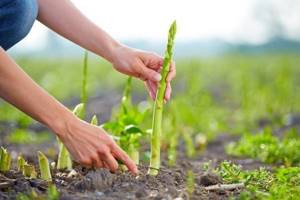
Caring for asparagus in open ground
One of the obvious advantages of this vegetable is its easy care. It comes down mainly to watering, loosening and fertilizing.
Watering
Asparagus is not a moisture-loving plant. It requires systematic watering, but in small portions. Both waterlogging, stagnation of moisture, and excessive drying out of the soil are detrimental to the crop.
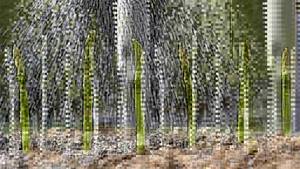
watering asparagus in the garden
Feeding
Asparagus is one of the plants susceptible to fertilizer. I checked it from my own experience - the yield of asparagus directly depends on the timeliness of fertilizing. As you remember, both in spring and autumn we plant the plant in already fertilized soil. After that I follow a simple schedule:
- About a month after sowing, I fertilize the planting with a solution of mullein (1 part dry mass to 5 parts water).
- Every year after harvesting (approximately by the end of June) I add mineral nutrition: per 1 m2 - 30 g of urea, 30 g of potassium salt, 30 g of superphosphate.
- By July (then the asparagus “starts to grow” again after cutting the crop), organic fertilizer is needed - for example, an aqueous solution of chicken manure (1:10).
- The last feeding of asparagus should be done before the first frost - in the last weeks of October. Most often I use a complex organic composition or add potassium salt and superphosphate (30 g of each preparation per 1 m2).
When flowering, asparagus does not need fertilizers - I successfully replace them with mandatory treatment with insecticides. This simple prevention allows you to forget about pests.

fertilizers for feeding the garden
Weeding and loosening
I have already written that asparagus does not do well when surrounded by weeds. Therefore, I periodically manually weed the bed once every 1-2 weeks.
I don’t forget to carefully loosen the plants after each watering or heavy rain, breaking up the dense earthen crust. Over the summer, the plant needs at least 7-8 such procedures.
Hilling
Asparagus grows on ridges - I pre-shape them when sowing or replanting the crop. As the plant grows, I maintain the height of the mounds, which are eroded by watering and rain. But only until the harvest - by April I carry out “unplanting”.
On a flat surface it is easier to notice the appearance of edible asparagus sprouts. This comparison of ridges gives the plant the opportunity to develop stems and accumulate more nutrients. After harvesting, I carry out hilling again.
In the fall, I cut off all ground shoots on both mature and young plantings. I hill up the plants again and additionally insulate them with a layer (about 5 cm) of compost or peat - you will need at least 1.5 buckets per 1 m2.
Storage
Asparagus can be stored in the refrigerator, wrapped in a damp cloth, from two weeks to four months, depending on conditions and variety. At this time, you should not put foods that have a strong and specific smell in the refrigerator, otherwise the vegetable will quickly become saturated with them. The shoots should be laid vertically, since asparagus is prone to deformation when stored horizontally.
You can also store vegetables perfectly in an ordinary wooden box in a cool, well-ventilated place (for example, in a cellar). To prevent the shoots from losing their softness and juiciness, they can be sprinkled with sand.
Another way to store asparagus for a long time is freezing. To do this, you should sort the shoots into thin and thick. Rinse the raw materials thoroughly and tie them into small brooms. Blanch the resulting bunches from thick shoots in boiling water for 4 minutes, from thin shoots for 2. Place the asparagus in plastic containers and freeze.
Diseases
Asparagus is a fairly disease-resistant plant, but even it is sometimes affected by uninvited guests in the form of invasive and infectious diseases.
Most common
Among the troubles that you may encounter when growing asparagus are the following:
- Rust. The disease is caused by pathogenic fungi and develops in several stages. Affected plants lag significantly behind their healthy relatives in development and practically do not produce shoots. Rust causes great damage to the next year's crop by causing asparagus to turn yellow prematurely in late summer before the root system has formed and buds have set at the base of the stems. Areas with moisture-impermeable soil and close groundwater are an ideal place for rust to develop.
Frequent and heavy rains also increase the plant's chances of encountering this problem even with the most careful care.
- Rhizoctonia . Another fungal disease of asparagus, the development of which is accompanied by stem rot, damping off and drying of the stem. Excessive watering, the use of unsterilized soil mixture and disruption of its structure, and the use of contaminated seeds significantly increase the plant’s chances of encountering rhizoctonia. Diseased asparagus must be destroyed as soon as possible.
- Asparagus fly . A small brown pest with yellow limbs, head and antennae. It feeds on asparagus shoots, making passages throughout the pulp. As a result of such vital activity of the parasite, the plant becomes distorted, withers and dies.
- Asparagus leaf beetle . An uninvited guest, imported from Western Europe directly with asparagus. This is a dark blue beetle, up to 0.5 centimeters in size, with a red border on the back, which tastes berries, flowers and asparagus tops. Outbreaks of parasite activity begin in spring, with maximum activity occurring in mid-summer.
- Fusarium . A disease caused by pathogenic fungi and is also known as root rot. Sick plants, starting in June, turn yellow, wither and dry out prematurely. When the base of the stems is damaged, brick or brown spots with a white fluffy coating form on them. The disease develops more often in older plants growing in conditions of high humidity.
Prevention and control
Preventive spraying of plants in the spring and autumn seasons will help protect asparagus from diseases. The following fungicides are used for this task:
- Bordeaux mixture (a mixture of copper sulfate and slaked lime);
- Topaz;
- Topsin M;
- Fitosporin.
Timely destruction of dead asparagus fragments and preventing the appearance of weeds in the plant’s growing area is the key to a stable and rich harvest.
In the fight against invasive diseases, positive results are obtained by treating asparagus with Karbofos, a low-toxic, odorless drug. Asparagus must be processed as soon as possible when the farmer detects the first signs of parasites. To minimize potential damage to the plant, the beds should be inspected on an ongoing basis, and if ovipositions are found, they should be collected and burned.
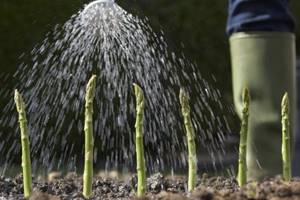
Caring for a plant at home
Caring for feathery asparagus is simple; it is enough to follow the conditions of maintenance and regularly carry out simple procedures.
Temperature
During the growing season (spring-summer), the most favorable temperature is +20-25 ºC. If the weather permits, the plant can be taken out to the open veranda.
In winter, the temperature is reduced to +12-16 ºC. If this is not done, the stems and shoots will begin to become bare, turn yellow, and the plant will lose its decorative appearance. In winter, asparagus is susceptible to drafts and sudden temperature changes.
Lighting
The flower prefers places well lit by diffused light. The most comfortable place is next to a window oriented to the west, east, north. When placing a plant on the south side, it must be shaded.
Asparagus pinnately tolerates the dark season without additional lighting.
Watering and humidity
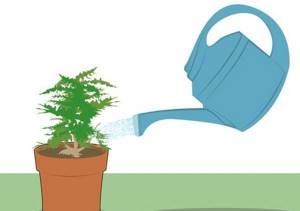
During the period of active growth, regular watering is required at least 3 times a week. Water the flower with settled water at room temperature. Do not allow water to stagnate in the soil; 20-30 minutes after the procedure, drain the water from the pan.
From November to March, the frequency of watering is reduced, but the earthen coma is not allowed to dry out. In February-March, with the beginning of new shoots growing, they gradually return to the summer watering regime.
The flower does not like excessively dry air; regular spraying and warm showers have a beneficial effect on it. You should not place the plant close to heating devices.
Top dressing
Feeding is required during the period of active growth (once every 2 weeks). In the autumn-winter period, asparagus is fertilized once a month. For feeding use:
- organic additives (infusions of slurry, citrus or banana peels, nettles, tea);
- complex mineral fertilizers for indoor flowers (Agricola, Kemira, Fertika Lux, Effecton, Radifarm);
- growth stimulants (Bud).
Good results are achieved by alternating organic and mineral fertilizers.
Trimming
When pruning, it should be taken into account that the development of asparagus is quite specific and is divided into several stages:
- Germination.
- Formation of the root system and stem without the formation of new organs (leaves, cladodes).
- Development of all parts of the plant.
Pruning will only bring results beyond the third stage of development. If the roots and shoots are not sufficiently developed and have not yet entered the full growth phase, pruning leads to a slowdown in development and even death of the plant.
Only trim bare, long, drying stems of adult asparagus or shoots damaged by diseases and pests. Overgrown shoots are cut out in the spring during transplantation, and diseased shoots are cut out immediately.
Transfer
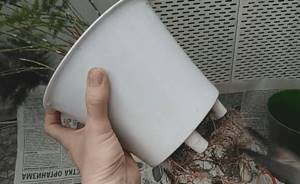
Transplantation is a necessary procedure for feathery asparagus. Young, low plants are replanted annually in March-April. When purchasing an adult plant, it is certainly replanted, transferring the earthen ball into a new pot with good soil.
In the future, replanting is done 1-2 times every 3 years, when the root system completely fills the pot.
For a successful transplant:
- drainage and prepared soil are poured into a pot of suitable size;
- carefully remove the flower from the old container, shake off the soil from the roots and trim them a little;
- the plant is placed in a new place, orienting the roots vertically;
- they are covered with earth on top, filling all the voids, but not to the very edge (the subsequent development of roots will raise the soil);
- the plant is watered moderately;
- a week later the first organic or complex mineral supplement is applied.
Reproduction
The plant can be propagated not only by seeds. The most productive division of a bush during transplantation is:
- The soil is shaken off from the plant removed from the ground;
- cut off dried roots and shoots;
- the rhizome is divided into several parts and treated with growth stimulants (Radifarm, Epin);
- fragments are planted in individual pots and for 3-4 weeks, the soil is moistened;
- seedlings are placed in a dark, cool place with a temperature of no more than + 15 ºC.
A more complex method is cuttings:
- healthy, green stems of at least 15 cm in length are cut from an adult plant;
- cuttings are rooted in water or soil;
- after the roots appear, “water” seedlings are planted in the soil;
- cover to create a greenhouse effect;
- the greenhouse is ventilated daily;
- Water the plant when the top layer of soil dries out.
Cuttings take a long time to take root. The root system begins to develop only after 1-1.5 months.
The best varieties
According to the criterion of appearance, asparagus is divided into 3 types:
- Green. The most common and popular variety of asparagus, which was cultivated in ancient Rome for medicinal purposes. It has good taste characteristics and is pleased with its high nutrient content.
- White. It has been cultivated since the beginning of the 19th century; it was and remains especially popular in Moscow. Also known as bleached, chlorophyll-free and etiolated. White asparagus is considered tastier than green, and its shoots have a more delicate texture.
- Purple. It is the rarest subspecies of asparagus. It has a specific taste and a slightly bitter aftertaste. When cooked, purple asparagus changes its color to green. This variety is low in calories and has high nutritional value.
The following varieties of asparagus have earned the greatest popularity among modern farmers:
- Cito . A high-yielding guest from France, whose hallmark is its unusually long shoots. This is an early hybrid variety, represented by exceptional male plants.
- Connovers Colossal . It is the most popular of the early asparagus varieties. The bushes form thickened shoots, which are especially good for freezing for the winter.
- Franklin and Limbras . High-yielding hybrid varieties, characterized by thick shoots and only males. Unlike most other asparagus varieties, Limbras and Franklin can be harvested the following year after planting.
- Lucullus.A relatively new hybrid variety of asparagus with male plants, considered more productive than older varieties. It is characterized by straight and tall shoots.
Asparagus varieties containing only male plants can be propagated solely by cuttings.
- Martha Washington . A very common, mid-early, high-yielding variety of American selection. It has increased resistance to rust, so it is recommended for growing in climate zones with high humidity. Martha Washington produces fairly long shoots in various shades of purple and red. In bright light, the color of the heads may take on a green tint.
- Arzhentelskaya . A foreign mid-early variety, modified by domestic selection. The variety is characterized by white-pink shoots that turn greenish-violet in the light. It has juicy and tender yellowish-white flesh.
- Gainlim . An early newcomer from abroad, characterized by a large number of tall shoots of outstanding quality.
- Early yellow . This variety is an achievement of Russian breeders. It is distinguished by good yield and resistance to diseases, early ripeness and tender yellow shoots with milky pulp.
- Glory of Brunswick . The long ripening period of asparagus is more than compensated by the amazing number of growing shoots with juicy white flesh. Best suited for canning.
- Tsarskaya . Asparagus of this variety is characterized by winter hardiness, drought resistance, and high resistance to fungal and invasive diseases. Green asparagus, ripening in the middle period.
Asparagus is a friendly crop for new farmers. To get a lot of tasty and healthy harvest, you will need to put in very little effort, attention and wait 2-3 years. And minimal care for the plant will provide the gardener with shoots for several decades.
0
0
Copy link
Growing in open ground
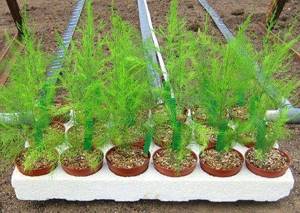
Planting material can serve as:
- Seeds. To ensure a guaranteed harvest, it is worth buying seeds of zoned asparagus hybrids of different ripening periods. Planting is carried out in ridges prepared in the fall immediately after the snow melts. Seedlings may appear in 3-4 weeks.
- Seedling. Pre-soaked seeds are planted in peat pots at the end of March. After the threat of return frosts disappears, they are planted in the ground.
- Division of an adult plant. Pieces of rhizomes with active buds are separated from the bush and transplanted to a new location. In this way, the plant can be propagated in May and early October.
Planting asparagus requires several steps.
- In a sunny place, a trench is dug about 30 cm deep and wide.
- The bottom is covered with a layer of well-rotted manure at least 10 cm thick and covered with fertile, well-drained soil.
- Seedlings are placed at a distance of 30–40 cm from each other. Water abundantly and mulch the soil.
Further care consists of weeding, regular watering and protection from pests. In autumn, the dried above-ground part is cut off, and the rhizome is covered with humus.
Attention! The following year, female bushes that produce berries are discarded. The remaining male plants are more productive and frost-resistant. The third season of asparagus life is the time to harvest the first harvest
Fruiting lasts for 20 years
The third season of asparagus life is the time to harvest the first harvest. Fruiting continues for 20 years.
The inability to obtain a full harvest at home should not upset fans of this wonderful plant. You can show your love for it by caring for indoor asparagus species.
And gourmets will be interested to learn about the latest European culinary fashion - collecting and eating wild forms of this vegetable crop
It is believed that asparagus, unspoiled by human attention, has a brighter, more natural taste.
